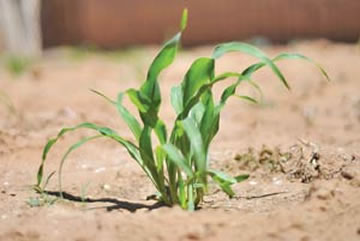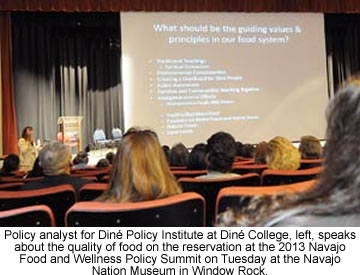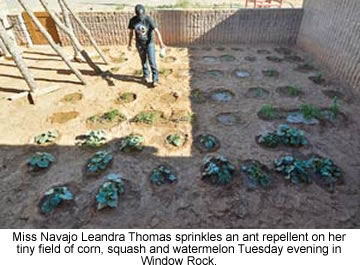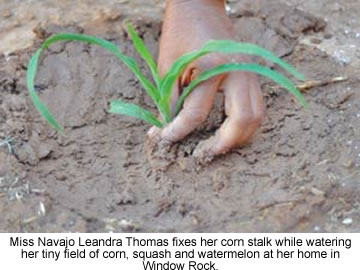 |
Canku Ota
|
 |
|
(Many Paths)
|
||
|
An Online Newsletter
Celebrating Native America
|
||
|
July 2013 - Volume 11
Number 7
|
||
|
|
||
|
Food Experts: Summit
Aimed at Preventing Extinction of Tribe
|
||
|
by Alastair Lee Bitsoi
- Navajo Times
|
||
|
credits: photos by Donovan
Quintero - Navajo Times
|
 WINDOW
ROCK — The goal of the 2013 Navajo Food and Wellness Policy Summit
is to develop a comprehensive food policy that will ensure the Navajo
people survive 5,000 years and beyond into the future. WINDOW
ROCK — The goal of the 2013 Navajo Food and Wellness Policy Summit
is to develop a comprehensive food policy that will ensure the Navajo
people survive 5,000 years and beyond into the future.
That's the major reason why Larry Curley, executive director for the Navajo Nation Division of Health, and tribal health officials sponsored the summit – to make certain the Navajo people never become an extinct tribe due to health disparities in their diet. "We'll obviously, it's a health related issue - the kind of food that we eat, the quality of food that we have, the access of the food that we have," Curley said about the prevalence of diabetes and obesity among Navajo people. He said about 13.7 percent of Navajo people are diabetic and 41 percent are overweight, or considered obese. Because of those alarming figures, Curley tasked his division workforce to look at the root cause – food. "We felt like the best opportunity was to bring in experts to help us shape the direction of the policy," Curley said about the invited food experts, who attended the two-day conference at the Navajo Nation Museum on Tuesday and Wednesday. The food experts included Emily M. Broad Lieb, director for the Food Law and Policy Division at Harvard Law School (see related story), Harry Tom from the Navajo Nation New Dawn Program, Western Navajo Food Policy Council member Angela Maloney and Dana Eldridge, policy analyst for Dine Policy Institute at Dine College, among others.
"Food can help reaffirm and strengthen the sovereign status of the Navajo Nation because we would be exercising our own policy and own culture and inculcating it into the food system," Curley said. One of those experts Curley is relying on to develop the comprehensive food policy is Eldridge, who has researched food sovereignty on the reservation over the past two years as a policy analyst. In her presentation about Navajo Food History and Navajo Food System Issues, Eldridge emphasized how vital policy is to the 100 or so people in attendance at the summit. "Policy is what got us here in the first place," Eldridge said, referring to the American policies of colonization that negatively impacted the Navajo people. "When you control a people's food systems, you have control over them as people," she added. She referenced how the diet of people changed from a pre-contact diet of wild animals and game and "plant based" to a "ration based" diet during the Long Walk up to the 1930s to Bureau of Indian Affairs Land Permit System and into the 1980s when soda and sweetened diets became part of the Navajo food system. She also noted how the current Navajo diet of fried potatoes, fry bread, tortillas, sugary drinks and processed meats have resulted in 1 in 3 Navajos being diabetic.
According to the U.S. Department of Agriculture, most of the Navajo reservation is considered a food desert. Being designated as a food desert means people have little access or no access to large supermarkets on their land to maintain a healthy diet, Eldridge said. "Food is a social justice issue," she added. As a consultant to Santa Fe-based Farm to Table, Tohatchi, N.M. native Elvis Bitsilly stated that he didn't know if it was possible to reintroduce what Eldridge referred to as a "plant base" diet, while large-scale commercialized agriculture has foodstuff readily available. "We can't really go back to what was," Bitsilly said. He explained that it would be impossible to challenge agricultural biotechnology companies like Monsanto, which controls about 70 percent of the world's food supply with plants that "would never cross in nature." "We can't change that," Bitsilly said with pessimism, as he was walking out of the museum auditorium disagreeing with Eldridge's presentation. The food and wellness policy summit also included various informational booths from the Navajo Nation Special Diabetes Project, Navajo Nation Health Education Program and a vendor booth set up by the American Beverage Association.
Thorp informed the Navajo Times about how the association has responded to consumers by printing calorie labels on sodas, juices, teas, waters and sports drinks, as well as replacing high-calorie options with smaller portion sizes. "We want to get the facts out there that beverage consumption is down and obesity rates keep going up," Thorp said. "To lay blame for the soft drink industry for obesity is unfair to single out one industry, one product for taxation." The taxation Thorp refers to is the movement by the Diné Community Advocacy Alliance, which is advocating for a junk food sales tax across the reservation. Thorp and the American Beverage Association came out to the Navajo Nation to lobby against the proposed law – Navajo Nation Junk Food Sales Tax Act of 2013, which is in draft form and being sponsored by Council delegate Danny Simpson (Becenti/Crownpoint/Huerfano/Lake Valley/Nageezi/Nahodishgish/Tse'ii'ahi/ Whiterock). From the summit's discussions and presentations by the food experts, Curley hopes a comprehensive food policy called the Navajo Nation Food and Wellness Act of 2013 would be developed. "There needs to be a policy," he said, adding that through it the federal commodity food and food stamps programs, for example, could be amended to offer healthier foods and choices to consumers. "Stores on the Navajo Nation need to become more health conscience," he added. "It is our responsibility as Navajo people." |
|
|
||
|
|
||
| Canku Ota is a free Newsletter celebrating Native America, its traditions and accomplishments . We do not provide subscriber or visitor names to anyone. Some articles presented in Canku Ota may contain copyright material. We have received appropriate permissions for republishing any articles. Material appearing here is distributed without profit or monetary gain to those who have expressed an interest. This is in accordance with Title 17 U.S.C. Section 107. | ||
|
Canku Ota is a copyright ©
2000 - 2013 of Vicki Williams Barry and Paul Barry.
|
||
 |
 |
|
|
The "Canku
Ota - A Newsletter Celebrating Native America" web site and
its design is the
|
||
|
Copyright ©
1999 - 2013 of Paul C. Barry.
|
||
|
All Rights Reserved.
|
||
 Curley
said the proposed policy, crafted in part by the insights of the
food experts, would help strengthen food sovereignty by written
law requiring, for example, healthy planting and produce, using
food to maintain culture and tradition, as well as reintroducing
farming practices as a natural part of life, among other aspects.
Curley
said the proposed policy, crafted in part by the insights of the
food experts, would help strengthen food sovereignty by written
law requiring, for example, healthy planting and produce, using
food to maintain culture and tradition, as well as reintroducing
farming practices as a natural part of life, among other aspects.
 "These
dietary changes did not occur by chance or choice," she said. "They're
really fostered by a set of American policies and interventions."
"These
dietary changes did not occur by chance or choice," she said. "They're
really fostered by a set of American policies and interventions."
 The
American Beverage Association set up their shop at the summit in
an effort to educate the public and tribal leaders of the beverage
industry since the industry is being blamed for the nationwide diabetic
and obesity epidemic, said David Thorp, senior director for the
association.
The
American Beverage Association set up their shop at the summit in
an effort to educate the public and tribal leaders of the beverage
industry since the industry is being blamed for the nationwide diabetic
and obesity epidemic, said David Thorp, senior director for the
association.